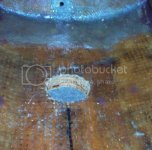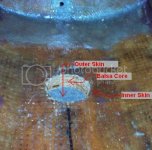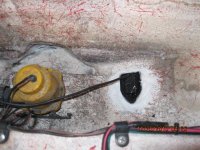I am installing a depth finder in my 1988 Exciter and I know you have problems with correct readings and balsa bottoms. I removed the tank and started grinding out an arer so I could expoxy in the transducer and there was no balsa in the floor? Whats up? Am I missing something, is there no balsa in the bottom a couple inches forward of the transom?
-
Welcome to the Checkmate Community Forums forums.
» Interact with over 10,000 Checkmate Fanatics from around the world!
You are currently viewing our boards as a guest which gives you limited access to view most discussions, articles and access to our other FREE features.
By joining our free community you will be able to:
» Post topics and messages
» Post and view photos
» Communicate privately with other members
» Access our extensive gallery of old Checkmate brochures located in our Media Gallery
» Browse the various pictures in our Checkmate photo gallery
Registration is fast, simple and absolutely free so please, join our community today!
If you have any problems with the registration process or your account login, please contact support by clicking here or by using the"contact us" link at the bottom of the page.
You are using an out of date browser. It may not display this or other websites correctly.
You should upgrade or use an alternative browser.
You should upgrade or use an alternative browser.
No Balsa?
- Thread starter Costa
- Start date
groundloop
Active member
I put a transducer in the bottom of my Eluder while I was rebuilding it, yours should be the same since Exciters and Eluders used the same hull. Can you post a photo of what you've got, it would help. Here's a photo of the hole I prepped before installing the transducer, it's maybe 8 inches or so in front of the transom centered on the pad.


groundloop
Active member
That didn't give up any structural integrity whatsoever. The cutout is less than 3 inches in diameter (just barely larger than the transducer), and of course the bottom skin was not harmed at all (just sanded to give a good surface to bond to). The transducer itself is plenty strong, and it's bonded in place with epoxy such that there are no voids (the transducer becomes part of the structure) - I wouldn't be surprised if the final result was actually stronger. I wish I'd have taken a photo after the transducer was mounted, if you saw it you'd understand.
This is a better way to mount a transducer than on the transom where 1) you drill screw holes and risk a rotted transom if not sealed perfectly; 2) the transducer will generate a lot of spray and may even mess up handling at higher speeds; and 3) the transducer is unreliable at planing speeds - especially on fast hulls. And finally, it's been done like this on cored hull bass boats for years.
This is a better way to mount a transducer than on the transom where 1) you drill screw holes and risk a rotted transom if not sealed perfectly; 2) the transducer will generate a lot of spray and may even mess up handling at higher speeds; and 3) the transducer is unreliable at planing speeds - especially on fast hulls. And finally, it's been done like this on cored hull bass boats for years.
Last edited:
groundloop
Active member
No, I didn't go all the way through (that would be disaster), and yes there's definitely balsa in the core. What you're seeing is, of course, the inner skin, then all around the perimeter of the hole is the balsa core, then at the bottom of the hole is the outer skin which was thoroughly sanded for better adhesion. And yes, to be technically correct, this is in-hull transducer mounting. I think the photo may be confusing because the view is so close in. I'm probably saying what you already know, these hulls are constructed like a balsa sandwich - there's the outer fiberglass skin (that's what gets laid up in the mold when they're building the boat), followed by balsa core, followed by the inner skin (which is hand laid glass cloth).
I was very very careful when making this cut-out. First I used a diamond wheel on my dremel to cut through the fiberglass skin. Then I used a small "router" bit on the dremel to slowly cut through the balsa. Finally I sanded the exposed surface of the outer skin with 60 grit sandpaper.

I was very very careful when making this cut-out. First I used a diamond wheel on my dremel to cut through the fiberglass skin. Then I used a small "router" bit on the dremel to slowly cut through the balsa. Finally I sanded the exposed surface of the outer skin with 60 grit sandpaper.

Dont know if this helps but here is what I did in my Pulsare. I traced around the transducer approx 1/4'' wider than the transducer itself. Then cut thru the top layer of fiberglass and popped it out. Then chipped the balsa wood out, sanded the bottom smooth, epoxied the transducer in and then once cured I siliconed around the transducer approx 1'' outward so there was no chance of water ever getting in around it, then mounted the guage in dash. I did this to my old pulsare and it worked flawlessly.
Also really makes it nice if you can put a shop vac hose right next to the hole while grinding it out so you dont have to breath all the dust.
Also really makes it nice if you can put a shop vac hose right next to the hole while grinding it out so you dont have to breath all the dust.
Attachments
MH, how do you like the depth finder? Thats the one I purchased. Is it pretty steady at speed?
Pros, Cons?
I had this exact one in my pulsare for like 9 years. It worked great, only problem I ever had is after about year 7 the guage went bad. I bought another one and just used the existing transducer of course. Sometimes in rough water or going really fast it might lose its reading but for the most part it works great and I had no complaints. It would read down to like 1.5' before it would flat line.


